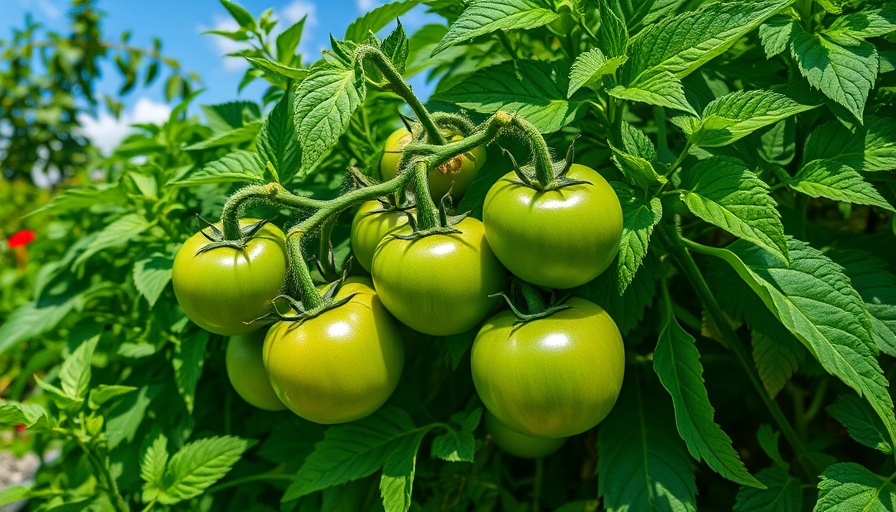
The Hidden Impact of Light Ratios on Flower Production
As gardeners in the Okanagan strive to cultivate lush, vibrant gardens, understanding the science behind plant growth is essential. A recent analysis sheds light on a fascinating phenomenon that can dramatically affect flower production: the ratio between red and far red light. This topic takes center stage as we unpack why your plants may be producing fewer flowers, especially if you are dealing with overcrowding in your garden.
In 'The Hidden Light Problem That KILLS Flower Production…', the discussion dives into the science of plant light ratios, exploring key insights that sparked deeper analysis on our end.
Understanding the Color Spectrum: Why Red Matters
Plants rely on light for various growth processes, and color plays a critical role in this dynamic. Red light, in particular, is vital for flower production. When a plant receives sufficient red light, it sends signals to produce flowers. However, if far red light dominates—often a consequence of overcrowding—the plant’s phytochromes, which act like light receptors, shut down flower production. This is a classic example of nature’s survival strategy: plants receiving inadequate light must either compete aggressively for resources or risk diminishing their growth potential. A healthy balance of red light encourages flowering, while far red light leads to leggy, foliage-heavy plants with few blooms.
How Overcrowding Disrupts Light Ratios
A key issue that many gardeners face is overcrowding, which can severely disrupt light ratios. When plants are densely packed, the amount of far red light increases in comparison to red light. It’s essential to ensure proper spacing between plants to facilitate adequate sunlight penetration. In my own garden, I noticed significant differences in flower production due to overcrowding. Those plants in the back received less sunlight, resulting in fewer flowers compared to plants that had more space to thrive.
Strategies for Fixing Overcrowded Gardens
So, what can you do if you find yourself with a crowded garden that is struggling? Here are two effective strategies:
- Apply Light Reflecting Mulch: If there’s visible soil in your garden, consider applying light-colored mulch. This helps reflect more light back to the plants, particularly beneficial for stimulating flower growth.
- Thin Your Plants: If your garden is lush but overcrowded, selectively thin some plants to allow sunlight to reach the remaining ones. This could involve removing lower foliage or even entire plants to improve airflow and light distribution.
Adapting your garden layout not only enhances light availability but also encourages a healthy growth environment for your plants.
The Biological Mechanics of Flowering: Phytochromes at Work
To fully grasp these concepts, it’s essential to understand how phytochromes function. These proteins play a crucial role in how plants perceive light. When red light is dominant, phytochromes remain active, signaling to the plant to produce flowers. Conversely, a dominance of far red light turns off these signals, effectively halting flower production. A 2021 review published in Plant Physiology observed this light ratio effect across various ornamental gardens and vegetable polycultures, further emphasizing the significance of proper plant spacing in maximizing flower yield.
Impact of Shade on Flower Production
The location of your garden plays a significant role too. Shady spots can reduce flowering potential even further. As observed in specific polyculture vegetable areas, a lack of sunlight can make it even more challenging for plants to thrive and produce blossoms. Adapting your garden to provide more sunlight can make all the difference.
Practical Tips for Optimal Spacing
When planning your garden layout, consider implementing these practical tips:
- Check the recommended spacing for each plant type to encourage airflow and light exposure.
- Regularly monitor plant growth and adapt spacing as necessary.
- Consider vertical gardening options, such as trellising, to maximize space and light availability.
These strategies ensure that your plants remain healthy, productive, and ready to bloom.
Engagement with the Gardening Community
The journey of gardening can feel overwhelming, especially when you encounter setbacks due to issues like overcrowding. But remember, you’re not alone! Engaging with fellow gardeners, sharing experiences, and discussing challenges can foster growth, both for your plants and your skills. Share your experiences—have you faced similar challenges? What solutions have you found effective?
A Reflection on Red Light and Garden Health
In the world of gardening, color isn’t just aesthetic; it’s crucial for plant health. Understanding the implications of light ratios opens a new avenue of conversation among gardeners about how to maximize their blooms. Whether your garden thrives or suffers could depend on something as simple as plant spacing and light exposure. So, the next time you stake and trim your tomatoes, remember to consider the impact of that critical red light.
As the growing season continues, let’s commit to learning and improving together. If you're interested in deepening your gardening knowledge, don’t hesitate to subscribe for more insightful content! Together, we will cultivate thriving gardens.
 Add Row
Add Row  Add
Add 




Write A Comment